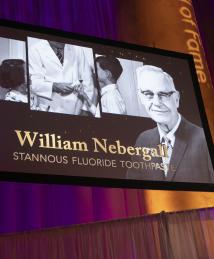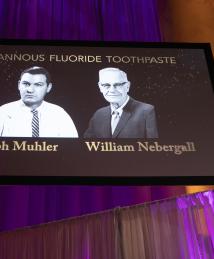William Nebergall
Dentist and biochemist Joseph Muhler and inorganic chemist William Nebergall developed a cavity-preventing product using stannous fluoride, building on research begun in the 1940s at Indiana University by then-undergraduate Muhler and biochemistry professor Harry Day. In 1956, Crest® toothpaste was introduced nationally. Four years later, it became the first toothpaste to be recognized by the American Dental Association as an effective decay-preventing agent.
At Day’s suggestion, Muhler had begun investigating a recently published method for measuring the fluoride content of teeth and bones. By the late 1940s, research showed that fluoride ions made tooth enamel harder and more resistant to attack, and the idea of using fluoride in toothpaste took hold. In 1949, Procter & Gamble Co. began funding Muhler and Day’s research; one year later, Nebergall joined the project. Nebergall worked on the inorganic chemistry aspects, producing high-purity stannous fluoride and compatible abrasives. Ultimately, Nebergall received three patents related to compounds created during his research.
The product was licensed to Procter & Gamble and, in the mid-1950s, the team introduced a formulation containing stannous fluoride. Stannous fluoride toothpaste was introduced in limited test markets in 1955. Crest debuted nationally in 1956. By the late 1970s, a steep nationwide decline in cavities was attributed in part to the widespread use of fluoride toothpaste. Today, all toothpastes with the ADA Seal of Acceptance must contain fluoride.
Nebergall received a bachelor of arts degree in education from Western Illinois State Teachers College (now Western Illinois University), a Master of Science degree in chemistry from the University of Illinois Urbana-Champaign and a doctorate in inorganic chemistry from the University of Minnesota.


